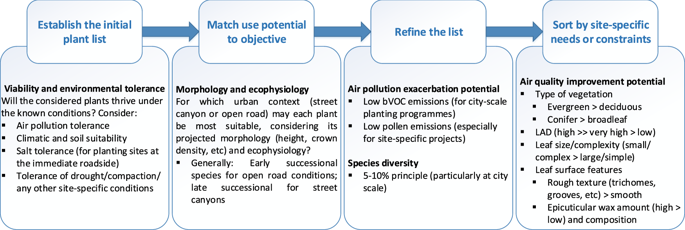npj Climate and Atmospheric Science ( IF 9 ) Pub Date : 2020-03-26 , DOI: 10.1038/s41612-020-0115-3 Yendle Barwise , Prashant Kumar

|
Vegetation can form a barrier between traffic emissions and adjacent areas, but the optimal configuration and plant composition of such green infrastructure (GI) are currently unclear. We examined the literature on aspects of GI that influence ambient air quality, with a particular focus on vegetation barriers in open-road environments. Findings were critically evaluated in order to identify principles for effective barrier design, and recommendations regarding plant selection were established with reference to relevant spatial scales. As an initial investigation into viable species for UK urban GI, we compiled data on 12 influential traits for 61 tree species, and created a supplementary plant selection framework. We found that if the scale of the intervention, the context and conditions of the site and the target air pollutant type are appreciated, the selection of plants that exhibit certain biophysical traits can enhance air pollution mitigation. For super-micrometre particles, advantageous leaf micromorphological traits include the presence of trichomes and ridges or grooves. Stomatal characteristics are more significant for sub-micrometre particle and gaseous pollutant uptake, although we found a comparative dearth of studies into such pollutants. Generally advantageous macromorphological traits include small leaf size and high leaf complexity, but optimal vegetation height, form and density depend on planting configuration with respect to the immediate physical environment. Biogenic volatile organic compound and pollen emissions can be minimised by appropriate species selection, although their significance varies with scale and context. While this review assembled evidence-based recommendations for practitioners, several important areas for future research were identified.
中文翻译:

设计减少城市空气污染的植被屏障:选择合适的植物物种的实用评论
植被可以在交通排放与邻近区域之间形成障碍,但是目前尚不清楚这种绿色基础设施(GI)的最佳配置和植物组成。我们研究了影响环境空气质量的GI方面的文献,特别关注开放道路环境中的植被屏障。为了确定有效的屏障设计原则,对结果进行了严格评估,并根据相关的空间尺度建立了有关植物选择的建议。作为对英国城市地理标志的可行物种的初步调查,我们收集了61种树种的12个有影响力性状的数据,并建立了补充植物选择框架。我们发现,如果干预规模很大,考虑到地点的环境和条件以及目标空气污染物的类型,选择具有某些生物物理特性的植物可以增强缓解空气污染的能力。对于超微米级颗粒,有利的叶片微形态特征包括毛状体和脊或沟的存在。气孔特征对于亚微米级颗粒和气态污染物的吸收更为显着,尽管我们发现此类污染物的研究相对较少。通常有利的宏观形态特征包括小叶片尺寸和高叶片复杂性,但是最佳植被高度,形态和密度取决于相对于当前物理环境的种植配置。通过适当的物种选择,可以最大程度地减少生物挥发性有机化合物和花粉的排放,尽管它们的重要性随规模和环境而变化。这篇综述收集了针对从业者的循证医学建议,同时确定了未来研究的几个重要领域。


























 京公网安备 11010802027423号
京公网安备 11010802027423号